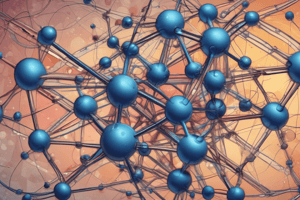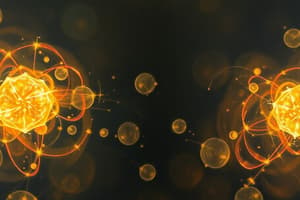Podcast
Questions and Answers
Which of the following properties is considered an intensive property of matter?
Which of the following properties is considered an intensive property of matter?
- Mass
- Temperature (correct)
- Length
- Volume
During a phase change, such as boiling, what happens to the temperature of a substance?
During a phase change, such as boiling, what happens to the temperature of a substance?
- It decreases until the phase change is complete.
- It remains constant. (correct)
- It increases linearly with heat input.
- It fluctuates unpredictably.
Which state of matter is characterized by particles having the highest kinetic energy and exhibiting rotational, vibrational, and translational motion?
Which state of matter is characterized by particles having the highest kinetic energy and exhibiting rotational, vibrational, and translational motion?
- Gas (correct)
- Liquid
- Solid
- Plasma
What type of mixture is saltwater?
What type of mixture is saltwater?
Which type of compound is defined by the presence of carbon-hydrogen bonds?
Which type of compound is defined by the presence of carbon-hydrogen bonds?
What is the primary difference between mechanical and non-mechanical methods of separating mixtures?
What is the primary difference between mechanical and non-mechanical methods of separating mixtures?
In the nomenclature of binary ionic compounds, what modification is typically made to the non-metal's name when it forms an ion?
In the nomenclature of binary ionic compounds, what modification is typically made to the non-metal's name when it forms an ion?
Why is it essential to balance charges when writing the formula for an ionic compound?
Why is it essential to balance charges when writing the formula for an ionic compound?
What distinguishes multivalent ionic compounds from binary ionic compounds in nomenclature?
What distinguishes multivalent ionic compounds from binary ionic compounds in nomenclature?
Which separation technique is best suited for purifying a liquid based on differences in boiling points?
Which separation technique is best suited for purifying a liquid based on differences in boiling points?
Flashcards
What is Matter?
What is Matter?
Anything that occupies space and has mass.
What are Physical Properties?
What are Physical Properties?
Observable without changing the substance (e.g., color, boiling point, density).
What are Chemical Properties?
What are Chemical Properties?
Observed when a substance transforms into another (e.g., reactivity, combustibility).
What are Extensive Properties?
What are Extensive Properties?
Signup and view all the flashcards
What are Intensive Properties?
What are Intensive Properties?
Signup and view all the flashcards
What is the Kinetic Molecular Theory?
What is the Kinetic Molecular Theory?
Signup and view all the flashcards
What are Elements?
What are Elements?
Signup and view all the flashcards
What are Compounds?
What are Compounds?
Signup and view all the flashcards
What are Homogeneous Mixtures?
What are Homogeneous Mixtures?
Signup and view all the flashcards
What are Heterogeneous Mixtures?
What are Heterogeneous Mixtures?
Signup and view all the flashcards
Study Notes
- Lessons provide foundational knowlege of matter, it's properties, and classification based on composition and energy interactions
- The documents cover nomenclature of ionic compounds and methods of separating mixtures
Lesson 1: Properties of Matter
- Matter occupies space and has mass
- Properties of matter include Physical and Chemical
Physical Properties
- Physical properties are observable without changing the substance
Chemical Properties
- Chemical properties are observed when a substance transforms (reactivity or combustibility)
Extensive Properties
- Extensive properties depend on the amount of matter (mass, volume)
Intensive Properties
- Intensive properties depend on the type of matter (color, solubility, temperature)
- Heat transfer affects molecular kinetic energy, increasing motion, and temperature
Lesson 2: Kinetic Theory of Matter
- All matter consists of particles in constant motion within kinetic molecular theory
- Energy and spacing determine the state of matter
States of Matter
- Solid particles vibrate, have high potential energy, and low kinetic energy
- Liquid particles move in straight-line motion and have medium kinetic energy
- Gas particles have rotational, vibrational, and translational motion with the highest kinetic energy
Phase Changes
- Heat energy changes kinetic energy and particle spacing
- Temperature remains constant during phase changes like melting and boiling
Physical Changes
- Physical changes include heat of fusion and heat of vaporization
Chemical Changes
- Chemical changes include heat of combustion and heat of formation
Lesson 3: Classification of Matter
- Matter has mass and volume
Pure Substances
- Elements are made of one type of atom (oxygen, carbon)
- Compounds are made of different atoms chemically bonded (water)
Mixtures
- Mixtures are physical combinations of substances
Homogenous Mixtures
- Homogenous mixtures have uniform composition (saltwater)
Heterogenous Mixtures
- Heterogenous mixtures have non-uniform composition (salad, colloids, suspensions)
Types of Compounds
- Organic compounds are carbon-based
- Inorganic compounds lack carbon-hydrogen bonds
- Ionic compounds contain charged ions
- Molecular compounds are formed by covalent bonds
Ionic Compounds
- Students should express ionic compounds in words or formulas (Lesson 5a, Page 1)
- Binary ionic compounds consist of one cation and one anion
- The metal is named first, and the non-metal's suffix changes to "ide" (chlorine to chloride)
- Chemical formulas have the metal symbol first, followed by the non-metal
- Subscripts balance the charges to achieve a net charge of zero
Multivalent Ionic Compounds
- Multivalent ionic compounds form more than one stable ion and follow similar naming rules
- Polyatomic ions retain their suffix
- Hydrates are compounds with chemically bound water molecules
Separating Mixtures
- Students should select appropriate methods for separating mixture components (Lesson 4, Page 1)
- Methods are mechanical or non-mechanical
- Mechanical includes decantation, filtration, centrifugation
- Non-mechanical includes chromatography, distillation
Mechanical Methods
- Mechanical methods include density separation techniques (decantation and centrifugation) for solid particles that pass through filters
Chromatography
- Chromatography separates based on solubility
- Types of chromatography: paper and thin-layer
Distillation
- Distillation purifies liquids based on boiling point differences
- Includes simple and fractional distillation
Froth Flotation
- Froth flotation separates hydrophobic components from hydrophilic, used in mining
Exercises and Assignments
- Activities for practical understanding and group assignments regarding methods of separation are included in both lessons
Vocabulary
- Ionic compound," "filtration," "chromatography," and others are key vocabulary
Polytomic and Multivalent Ions
- Students will differentiate between univalent, polyatomic, and multivalent ions
- Polyatomic ions consist of multiple atoms and can be represented as Lewis Structures
- Naming conventions include suffixes like "ate" and "ite," and prefixes "hypo" and "hyper"
- Nomenclature rules for cations and anions are covered with emphasis on understanding structure
- Common examples of polyatomic ions: ammonium (NH4+), nitrate (NO3-), nitrite (NO2-), carbonate (CO32-), sulfate (SO42-), sulfite (SO32-), and phosphate (PO43-)
- Some transition metals form ions with more than one charge (Fe2+ and Fe3+)
- Denoted in naming (iron (III) chloride)
- Oxyanions consist of a central element bonded to several oxygen atoms
Nomenclature of Compounds
- Students will represent molecular compounds in words or formulas
Nomenclature of Ionic Compounds
- Includes rules for naming ionic compounds
- Includes the replacement of suffixes for certain non-metals (fluorine to fluoride)
- Includes the use of prefixes to indicate the number of atoms
Nomenclature of Covalent Compounds
- Presents rules for naming covalent compounds
- The order of naming is based on the chemical formula and the use of Greek prefixes
Writing Formulas
- Lesson provides formula writing examples
- Discusses the IUPAC system for naming complex covalent compounds, such as glucose (C6H12O6)
Activites
-
Activities help practice compound naming
-
Examples: chemicals bingo and chemistry jeopardy
-
Lessons provide understanding of ion composition and nomenclature
-
Provides the rules governing naming of both ionic and covalent compounds
Studying That Suits You
Use AI to generate personalized quizzes and flashcards to suit your learning preferences.
Related Documents
Description
Explore matter's fundamental properties, including physical, chemical, extensive, and intensive characteristics. Understand the kinetic theory, detailing particle motion and energy interactions. Learn about classifying matter based on composition and energy dynamics.




